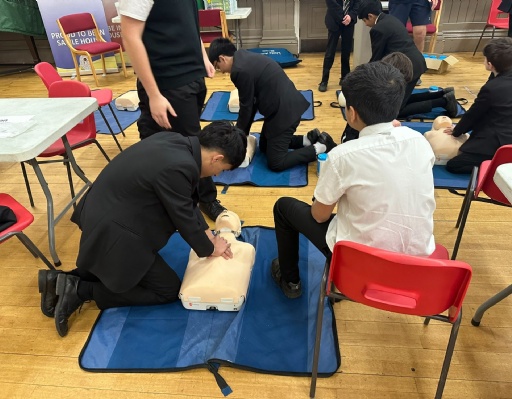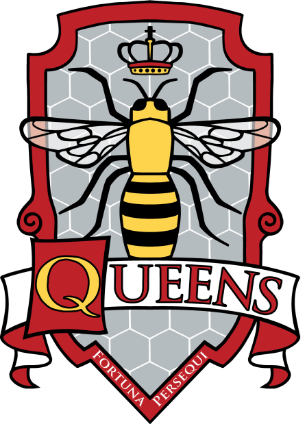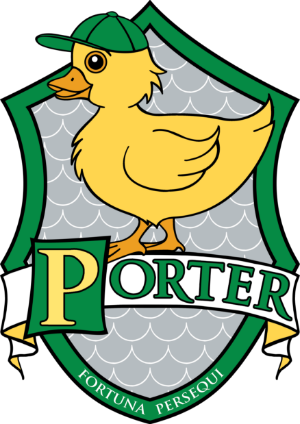Unlocking potential; building leaders of the future
Courage
Excellence
Kindness

Welcome from the
Headteacher
We truly look forward to welcoming students to The Crossley Heath School and championing their success throughout every moment of their time with us. Our vision is to be the leading school for educational excellence, where we nurture happy students with strong values, so they all contribute positively to society. The happiness of our students really matters to us. We know that academic achievement will give them the brightest choice of future careers which will allow them to be happiest. Our aspiration is for our students to spread happiness too as positive role models for our values of kindness, courage and excellence. Our students will influence society for the better , leaving our school committed to making the world a better place.



Latest News

20 December 2024
Christmas Celebrations
We ended 2024 on a high with both our annual Carol Service and our Multi-Faith Celebration.
Read full Article

15 December 2024
Annual Carol Service
Our annual Carol Service for students, parents, families and alumni at the Halifax Minister is returning for 2024!
Read full Article

11 December 2024
Year 9 Boys Cricket
2 wins from 2 for the Y9 Boys Indoor Cricket Team after beating Trinity Academy Halifax on Wednesday.
Read full Article

08 December 2024
Number 1 for Progress 8
Proud of our Crossley Heath School family as we continue the tradition of being the highest achieving school for both GCSE attainment and progress in Calderdale.
Read full Article

29 November 2024
Did someone say the Quarter Finals!?
Crossley's First XV had a convincing 34-7 win tonight to move onto the last 8 in the national cup!
Read full Article

28 November 2024
Fundraising for a Community Defibrillator
We are fundraising to purchase an AED (defibrillator) for 24/7 community use on our moor gate.
Read full Article
.png)
22 November 2024
TOG24 Crossley Heath clothing range
Yorkshire's TOG24 launch new Crossley Heath School outdoor clothing range
Read full Article
.jpg)
18 November 2024
School Lettings
Did you know you can hire our facilities?
Read full Article

11 November 2024
Rotary Shoe Box Appeal
This festive season, Crossley Heath are once again taking part in the Rotary Shoebox Appeal. Many people in our community find themselves struggling during the run up to Christmas...
Read full Article

OUR HISTORY
The Crossley Heath School is steeped in well over 400 years of tradition and has survived many different phases in its long history to become a central part of the community of Halifax and a hugely successful school. 1985 saw probably the biggest change when Crossley and Porter School amalgamated with Heath Grammar School to form the Crossley Heath School.
1857
Heath Grammar School
The Crossley Heath school building owes its existence to the philanthropy of the Crossley brothers , Francis, John and Joseph. In 1857, they formulated a scheme for the establishment of a ‘superior College for the district’. Building work began the same year but by 1861 the brothers had decided to establish an ‘Orphan Home and School for Boys and Girls’. With the building work complete, the first six orphans, all boys, arrived in June 1864, although there was no official opening ceremony and much internal furnishing work remained to be completed. The first boy to be admitted was James Labron Plint.
1887
1887
In 1887, Thomas Porter, a Manchester yarn merchant, made an endowment of £50,007, on condition that the institution be renamed ‘The Crossley and Porter Orphan Home and School’, as approved by supplemental Royal Charter. The extra funding allowed orphan numbers to remain between 240 and 265 until the First World War and also facilitated the purchase of land opposite the southwest façade and a nearby site, where a sanatorium was built. Scholarships to Bradford Grammar School were introduced, academic standards contining to improve into the twentieth century.
1585
1585
The first significant date in this history of Heath Grammar School is February 15th 1585 when Queen Elizabeth signed the charter establishing “the free grammar school of Queen Elizabeth.”
Dr John Favour, Vicar of Halifax from 1593 to 1624, is regarded as the founder of the school being responsible for obtaining the piece of land upon which the first school was built – two acres of barren heath land donated by Henry Farrar in 1597. This, together with money donated by Sir John Savile, enabled the first Heath school to be built, opening in 1600.
Heath Grammar School was built by the Ackroyds of Hipperholme. There was a schoolhouse and a house for the master, adjacent to it. The old road leading to it became Free School Lane.
1600
1600
In 1600 Richard Wilkinson was Master followed in 1603 by Robert Byrron to 1620. School furniture was bought and as the first charter said, “the bringing up, teaching and instructing of Children and Youth of the said Parish and Vicarage of Halifax, and also of other Villages and Hamlets near adjoining unto the same………..in Grammar, and other good Learning, to continue for ever.”
Two sections of the original school remain today – a stone plaque and the Apple and Pear window. The window, which is unglazed, was constructed by John Akroyd(1556-1613) and sons, masons, and formed part of the gable wall of the original building. It was moved intact to its present site in 1879. At the front of the 1879 school, set above the front door, is a replica window, this one glazed and with an inscription where the word “GRAMMER” is, quite wrongly, spelt.
1612
1612
It is documented that in 1612 school began at 6am.and finished at 5pm with a break from 11am.to 1pm. Sunday was free, as was Thursday afternoon, and Saturday morning was given over to religious instruction. A master was in charge assisted by an usher, a sort of deputy, often unqualified. The boys were expected to make their way to school without noise or playing and to take off their caps to those they met. Whilst in school they spoke only in Latin not English.
1771
1771
There was a succession of Masters across the eighteenth century, bringing mixed fortunes, but with the leadership of Richard Hudson (1771-1782) and Gough Willis Kempson (1783-1788), Heath entered a period of time during which it flourished. The curriculum was broadened from just Latin, Greek and English and the school and school house were enlarged. Whilst still only a one room building, the school could take 60 boys and the house was big enough for the master, his family and 30 boarders.The flourishing of the school must in some part have reflected the expanding commercial activity of Halifax leading to an increased demand for education. Also the end of the 18th century saw some changes in land ownership and use, returning a profit to the school. By 1812 the first bank account was opened and Heath was led by Robert Wilkinson (1789-1839) succeeded by John Henry Gooch, then Thomas Cox. This period saw both Gooch and Cox thwarted in their attempts to make Heath a public school, as had other similar endowed schools. Changes, in every respect badly affected the fortunes of Heath. Plans to sell land to generate income were postponed to the 1860s. In 1869, the Endowed Schools Act sought to reorganise education with Heath fighting, but failing, to avoid this by claiming to be a Church of England School, and having reorganisation imposed in 1873. Gooch had added mathematics to the curriculum, and Cox added “a systematic study of English Literature and the French Language, and a more extensive acquaintance with Divinity.” There was also provision for Drawing, Drill, Science, Chemistry, Geography, History, Art and Book-Keeping.
1914
1914
At the Golden Jubilee celebrations in June 1914, the schools were looking forward optimistically, with new classrooms being opened and science laboratories planned. The Old Boys’ Association had donated new playing fields at Broomfield. In the summer, extensive improvements to the heating, lighting and sanitation delayed the start of term until October. However, with the onset of war everyday costs escalated, subscriptions dropped again and annual deficits of around £1,000 became the norm. The Governors decided neither to decrease numbers nor to increase fees, to spare orphans and their families further hardship, and Francis Crossley’s son, Sir Savile Brinton Crossley, Lord Somerleyton from 1916, pledged an extra £650 per annum from the Crossley family.
1939
1939
The Second World War again disrupted school life. As during the Great War, male staff joined the armed forces and boarders were evacuated to local families. Remaining male staff became air wardens and special constables and a school cadet force was established. As with many schools and colleges throughout the country, Crossleys shared its premises. Whitelands Training College for Elementary School Teachers took over the top two floors of the school as as a hostel for its first year students. The 1944 Act abolished the Board of Education, designated a Minister of Education to oversee local education authorities (LEA) and made secondary education compulsory. The schools became voluntary controlled secondary (grammar) schools, with a governing body consisting of five Foundation Governors and 10 Representative Governors, the latter appointed by the LEA. This arrangement abolished junior sections and fees, the junior section duly closing in 1947, with boarding in the main school building being officially discontinued. The Parents’ Association had been formed in the uncertain climate of 1945 and over subsequent decades it provided a valuable social and fund-raising support for the school.
1964
1964
In 1948, with the family’s agreement, the Standeven endowment was used to purchase two new hostels for boarders near Broomfield. The former ‘Ravenswood’ was renamed ‘Standeven House’ in memory of Mrs Standeven. It could accommodate 16 boys and nearby Crossley House (formerly ‘The Gleddings’) had room for 16 girls. The hostels never reached full capacity and closed in 1961, when the last boarders left. ‘The Gleddings’ was sold and Standeven House was converted for use as a pavilion by the Old Scholars’ Association, whose members had extended and developed the adjacent playing fields.
1985
1985
Still with separate Heads, the boys’ and girls’ schools celebrated their centenary together in 1964 and, with everyday co-operation increasing, they were officially merged, under one Head, on 1 January 1968. Changes in society in general and education in particular affected the grammar school, although it survived the move toward comprehensive education. However, falling school rolls and limits on public finance highlighted an over provision of grammar school places in Calderdale. Accordingly, in 1985 the Crossley and Porter School was merged with Heath to form the Crossley Heath School.
1990
1990
The merger of Heath Grammar School and Crossley and Porter Schools to form Crossley Heath School took place in 1985 after 400 years and 121 years respectively. The school building at Heath continued to be used until 1988 during the amalgamation period. The first Head was Mr Paul Barker, previous Head of Crossley and Porter School, leading a school of about 1100 students across the two sites, reducing to around 700 by 1990 before increasing to around 1000 currently through a programme of increased admissions in year 7. The late 1980s saw a period of continuous debate about the future direction of the new school amongst all interested parties – parents, governors and Calderdale Council. There was uncertainty over moves towards comprehensive education, further amalgamations and the creation of Sixth form teaching centres. The 1988 Education Reform Act enabled the creation of Grant maintained schools, free of council control and directly funded by the Government. Mr Barker retired after 14 years in 1991 at the stage when Crossley Heath became Grant maintained, one of the first schools in Calderdale to do so.
1991
1991
Mr John Bunch, former Head at Heath, succeeded as next Head taking the school through this opt-out phase. Academic success continued to flourish after amalgamation – perhaps the friendly rivalry encouraged healthy competition! Results year on year continued to improve despite the enormous pace of change in education, with such innovations as AS Levels as part of the Curriculum 2000 changes putting pressure on both staff and students.
1998
1998
In September 1998 Crossley Heath was one of only 75 schools awarded the status of “Beacon School”, a government initiative encouraging the sharing of good practice by working in partnership with other schools, and developing new ideas across all areas of the curriculum. Funding for the Beacon scheme finished in 2003, Crossley Heath having run many courses and classes.
2001
2001
Mr Bunch retired in 2001 and Miss Helen Gaunt was appointed as Head, vowing to continue to balance tradition with new ideas and strategies. One of the most important successes of her leadership was achievement of Language College status in 2003 allowing further refurbishment of that wing of the school. A successful fundraising campaign resulted in the building of a new sports hall in 2010. Miss Gaunt left in 2011.
2012
2012
Mrs Wendy Moffat was appointed as Head in 2012. Results continued to rise steadily and Crossley Heath School is now known as the highest performing state school in West Yorkshire. Under Mrs Moffat’s leadership the school became an academy and another successful fundraising campaign saw the creation of a new sixth form centre and collaborations with other providers, including Calderdale College, who were able to provide alternative pathways for some of the students. The school also celebrated its 150th anniversary with a variety of activities throughout the year.
2017

2017
Mrs Moffat retired in 2017, with Mrs Lynnette Cassidy taking over the post. Mrs Cassidy led the school through the COVID-19 Pandemic, and secured our "Good" Ofsted rating.
2024
2024
Mr Jones joined the school in 2024, with a vow to celebrate the history of the Crossley Heath School as well as impleting the vision of becoming the leading school for educational excellence, where we nurture happy students with strong values, so they all contribute positively to society.














